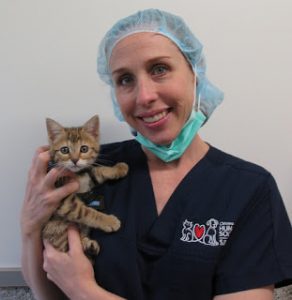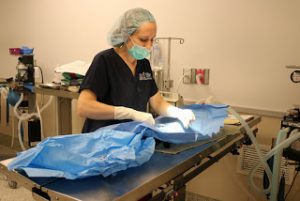November 17, 2016
Life as an OHS Shelter Veterinarian
 I’m often asked, “What is it like to be a veterinarian at the OHS?” There is no one word or single sentiment that sums it up. It’s busy, exciting, challenging, fun, and rewarding. There are moments of joy and times of sadness. It’s everything I ever thought being a veterinarian would encompass, and more.
I’m often asked, “What is it like to be a veterinarian at the OHS?” There is no one word or single sentiment that sums it up. It’s busy, exciting, challenging, fun, and rewarding. There are moments of joy and times of sadness. It’s everything I ever thought being a veterinarian would encompass, and more.
Working in a shelter differs substantially from veterinary medicine in a private practice:
- In a shelter, we’re typically dealing with animals with no known history. This leaves us to piece together their medical needs from a careful physical examination alone.
- We practice high quality, high volume, spay and neuter techniques to allow us to perform surgery safely and efficiently, giving a second chance to as many animals as possible. These techniques are specialized and are typically used in shelters and spay/neuter clinics across North America.
- Infectious disease is something we also face much more often than would be seen in general practice. In handling infectious disease cases, the health of the entire population has to be considered in our treatment plan. Our patients have often had no previous preventive health care such as vaccinations, internal and external parasite treatments, sterilization or dental care.
All of these things make shelter medicine a unique and challenging specialization of veterinary medicine. To be a successful shelter veterinarian, you need to be efficient, hard working, compassionate, and exhibit good clinical judgement. On top of all this, excellent surgical skills are a must.
I often chat with my veterinary colleagues about my work days. Those who work in general practice are astounded when I mention the volume of work we manage to do in a day at OHS:
- Days begin by assessing the animals in critical care, the unit where the OHS’s sickest animals stay. Usually we will have six to eight patients in critical care to check on first thing in the morning.
- We then move on to pre-operative examinations. All OHS animals that will have surgery that day will receive a pre-operative examination from a veterinarian. We usually book 20-30 surgical procedures per day, and our goal is to have these completed by lunch time.
- Our afternoons are spent assessing any sick or injured animals in the shelter. Usually this involves examinations and treatment plans for 40 or more individual animals.
- On top of our routine work load, we deal with emergencies as needed.
- As the chief veterinarian, I am also tasked with overseeing medical and surgical protocols, managing overall shelter health, managing our veterinary team including our community volunteer veterinarians, and providing case consultation on complex medical cases.
 I often get asked “how do you do it?” by people wondering about all the abused, abandoned and neglected animals I see daily. I always reply that I am simply thankful that we are here to help those in need. I can’t change what has already happened but I can help change the future.
I often get asked “how do you do it?” by people wondering about all the abused, abandoned and neglected animals I see daily. I always reply that I am simply thankful that we are here to help those in need. I can’t change what has already happened but I can help change the future.
I know that every single day that I come to work, I am making a difference in the lives of many animals and giving them a second chance. Seeing an animal that I have cared for recover from being sick or injured in our critical care unit to being well and finding a new home brings an indescribable feeling of fulfillment and joy.
I also know that I contribute to not just the work I do on a day to day basis but the work of our organization in public education, sterilization, and advocacy that will bring a brighter future for our community’s animals.
Most of all, I know that I am lucky to be able to practice my profession in such a progressive, kind, caring and compassionate organization that is the Ottawa Humane Society…and the cuddles from the four-legged friends I meet along the way are a pretty great perk too!
Dr. Shelley Hutchings
Chief Veterinarian
